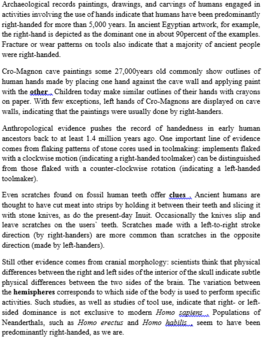Read the following passage and mark the letter A, B, C, or D on your answer sheet to indicate the correct answer to each of the questions.
Fish that live on the sea bottom benefit by being flat and hugging the contours. There are two very different types of flatfish and they have evolved in very separate ways. The skates and rays, relatives of the sharks have become flat in what might be called the obvious way. Their bodies have grown out sideways to form great “wings” They look as though they have been flattened but have remained symmetrical and “the right way up”. Conversely fish such as plaice, sole, and halibut have become flat in a different way. There are bony fish which have a marked tendency to be flattened in a vertical direction; they are much “taller” than they are wide. They use their whole vertically flattened bodies as swimming surfaces, which undulate through the water as they move. Therefore when * their ancestors migrated to the seabed, they lay on one side than on their bellies. However, this raises the problem that one eye was always looking down into the sand and was effectively useless - In evolution this problem was solved by the lower eye “moving” around the other side. We see this process of moving around enacted in the development of every young bony flatfish. It starts life swimming near the surface, and is symmetrical and vertically flattened, but then the skull starts to grow in a strange asymmetrical twisted fashion, so that one eye for instance the left, moves over the top of the head upwards, an old Picasso - like vision. Incidentally, some species of 20 flatfish settle on the right side, others on the left, and others on either side
The passage is mainly concerned with:
A. symmetrical flatfish
B. bony flatfish
C. evolution of flatfish
D. different types of flatfish




Đáp án C
Đoạn văn chủ yếu liên quan đến:
A. cá thân bẹt đối xứng
B. cá thân bẹt xương
C. sự tiến hoá của cá thân bẹt
D. các loại cá thân bẹt khác nhau
Thông tin ở câu: “ There are two very different types of flatfish and they have evolved in very separate ways” (Có hai loài cá thân bẹt và chúng tiến hóa theo các con đường khác nhau.) “In evolution this problem was solved...” Trong quá trình tiến hóa, vấn đề này đã được giải quyết.
Ngoài ra từ “flatfish” cũng xuất hiện nhiều lần trong bài và bài này đề cập đến những vấn đề thích nghi của loài cá này trong quá trình tiến hóa => Đáp án C. evolution of flatfish là đáp án đúng
Dịch bài
Cá sống dưới đáy biển có lợi bởi việc phẳng và siết chặt các đường viền. Có hai loài cá thân bẹt và chúng tiến hóa theo các con đường khác nhau. Cá đuối quạt và cá đuối, họ hàng của cá mập đã trở nên dẹt theo một cách có thể được gọi là rõ ràng. Cơ thể của chúng đã phát triển ngang để tạo thành những "đôi cánh" lớn. Chúng trông như thể chúng đã được làm phẳng nhưng vẫn cân đối và "phát triển đúng cách". Ngược lại, những loài như cá vược, cá bơn, và cá chim lớn đã trở nên dẹt theo một cách khác. Có những loài cá xương có khuynh hướng phẳng ra theo hướng dọc; chúng "cao" nhiều hơn là rộng. Chúng sử dụng toàn bộ cơ thể phẳng của chúng làm bề mặt bơi, mà tạo những gợn sóng qua nước khi chúng di chuyển. Vì thế, khi tổ tiên của chúng di cư xuống đáy biển, chúng đã nằm một bên chứ không phải trên bụng. Tuy nhiên, điều này làm nảy sinh vấn đề mà một mắt nhìn xuống cát và kết quả là khá vô ích - Trong tiến hóa vấn đề này đã được giải quyết bằng việc mắt dưới "di chuyển" xung quanh bên phía còn lại. Chúng ta có thể thấy quá trình di chuyển này đã được phổ biến trong sự phát triển của tất cả các cá thể cá thân bẹt xương trẻ. Nó bắt đầu bơi gần bề mặ nướct, và đối xứng phẳng và theo chiều thẳng đứng, nhưng sau đó hộp sọ bắt đầu phát triển theo kiểu xoắn bất đối xứng kỳ quặc, vì thế mắt một bên trái, di chuyển trên đỉnh đầu lên trên, theo kiểu Picasso cũ - như ảo cảnh. Ngẫu nhiên, một số loài gồm 20 loài cá thân bẹt nằm phía bên phải, một số khác ở bên trái, và một số khác ở hai bên